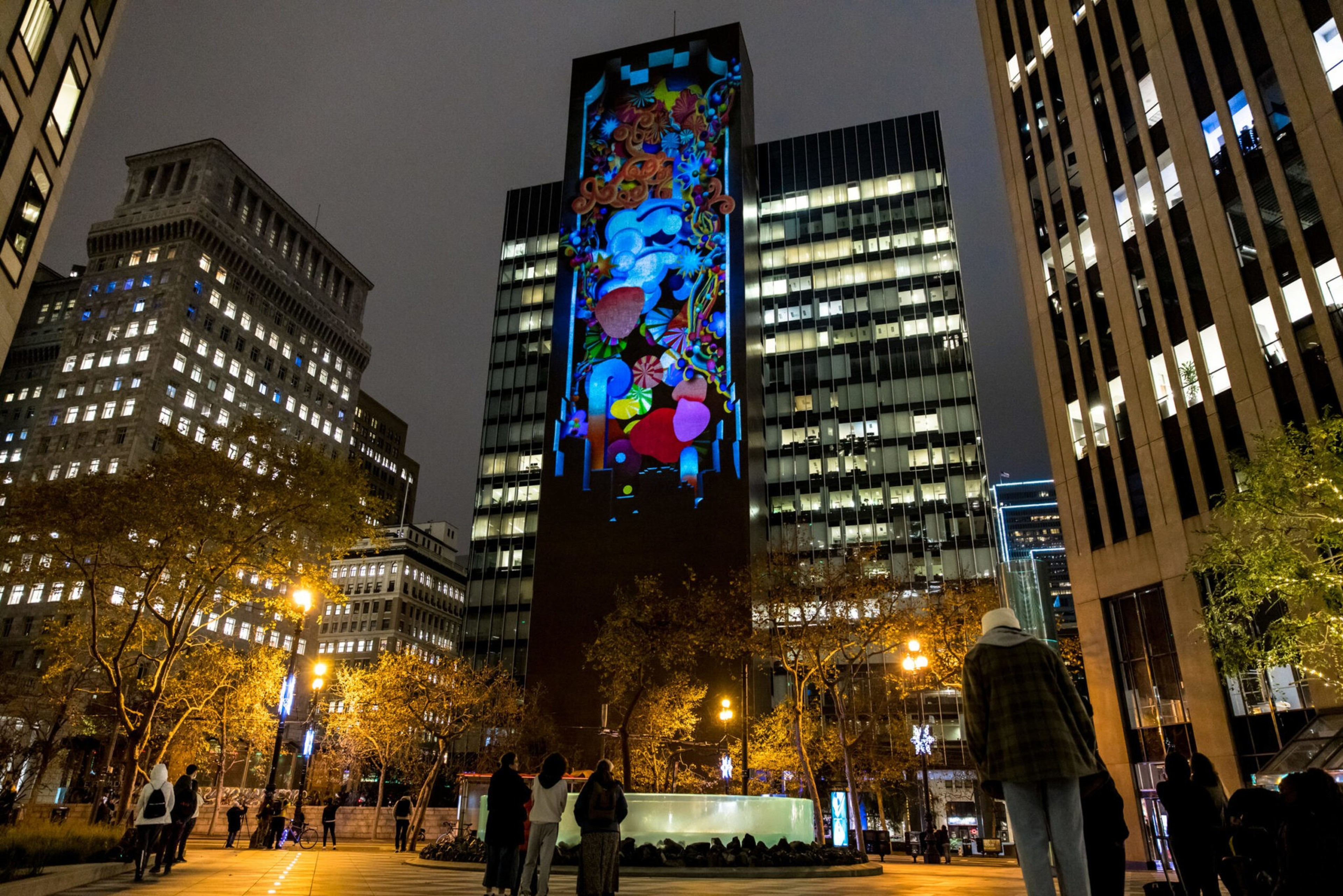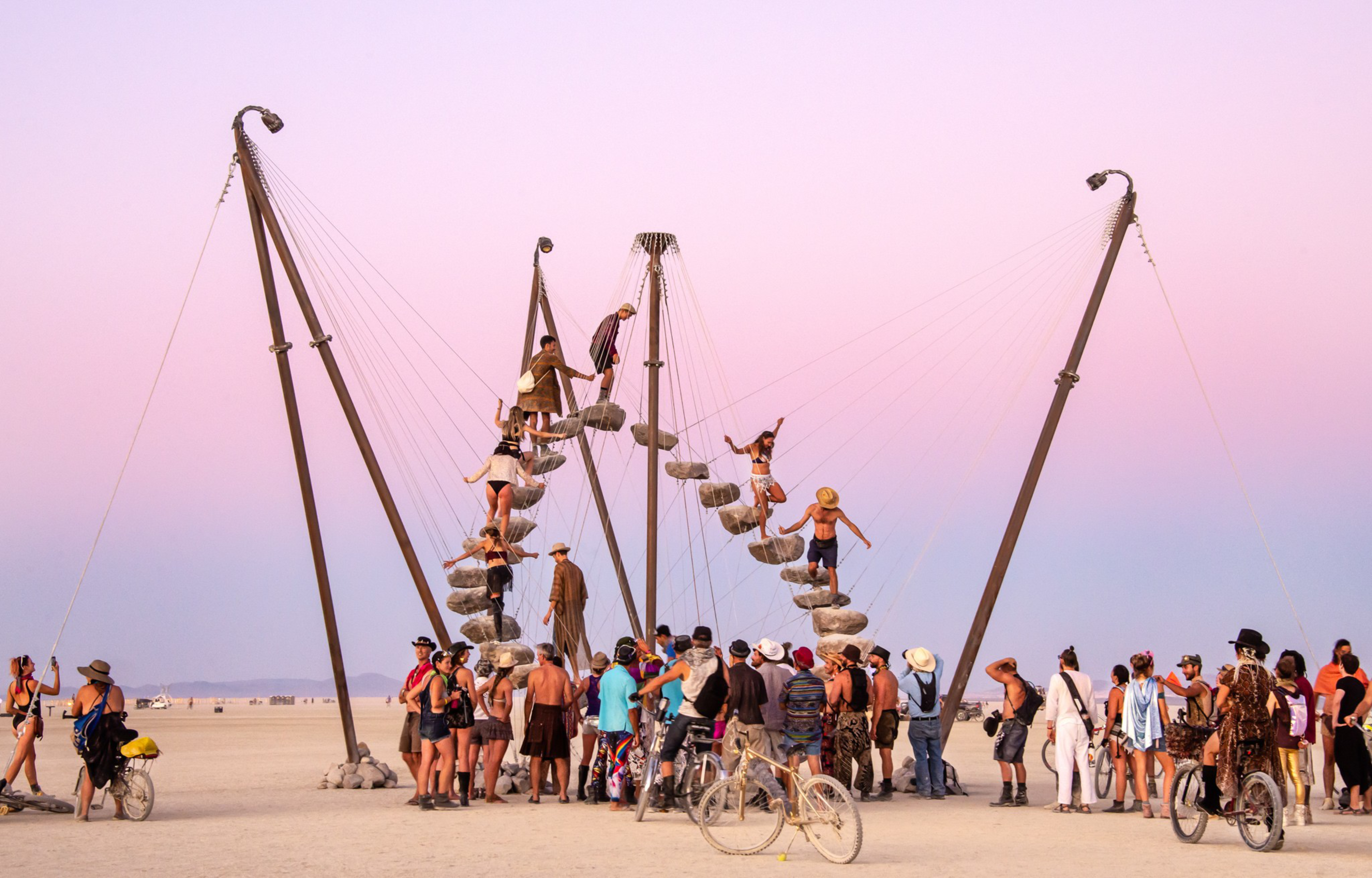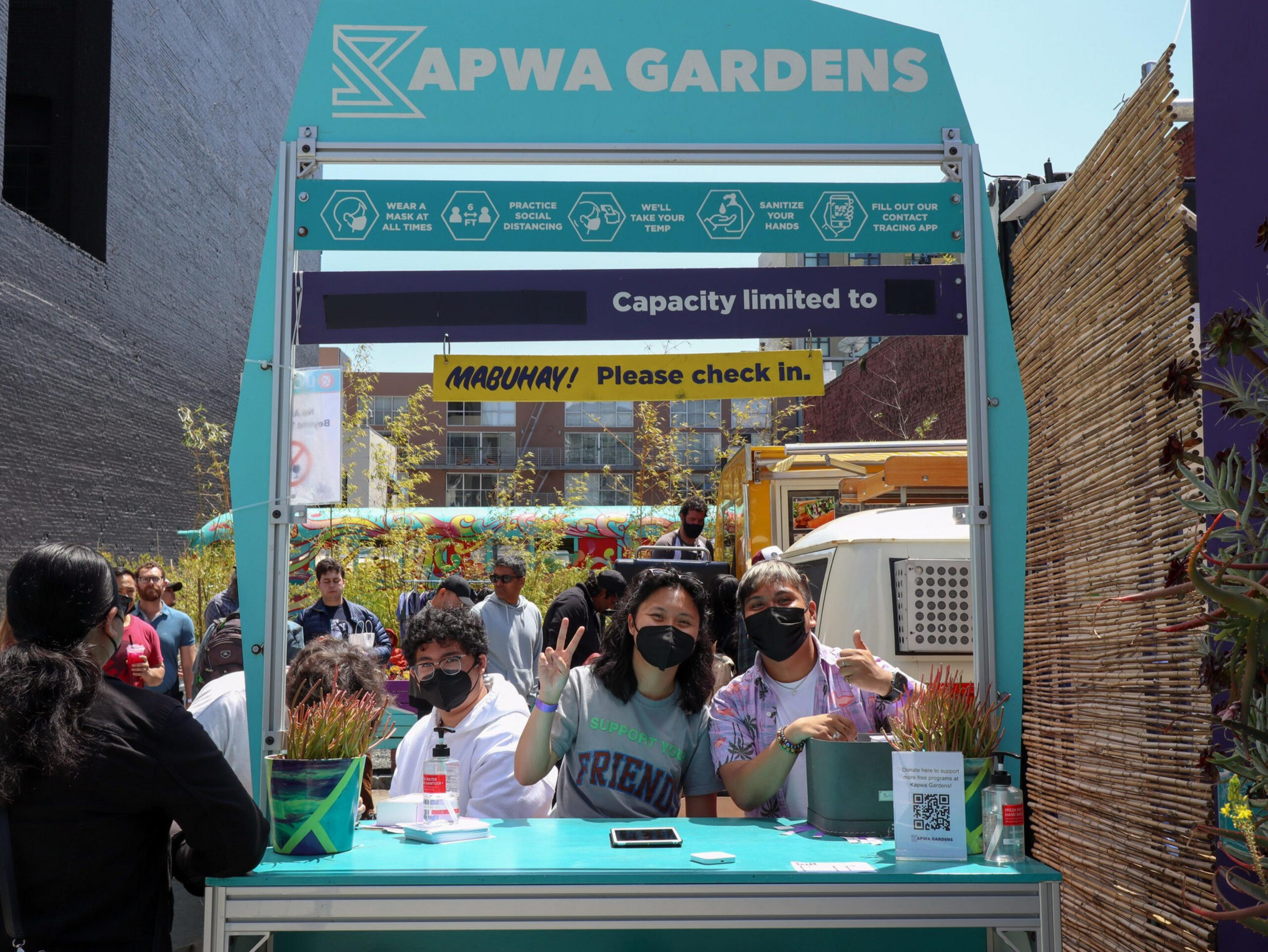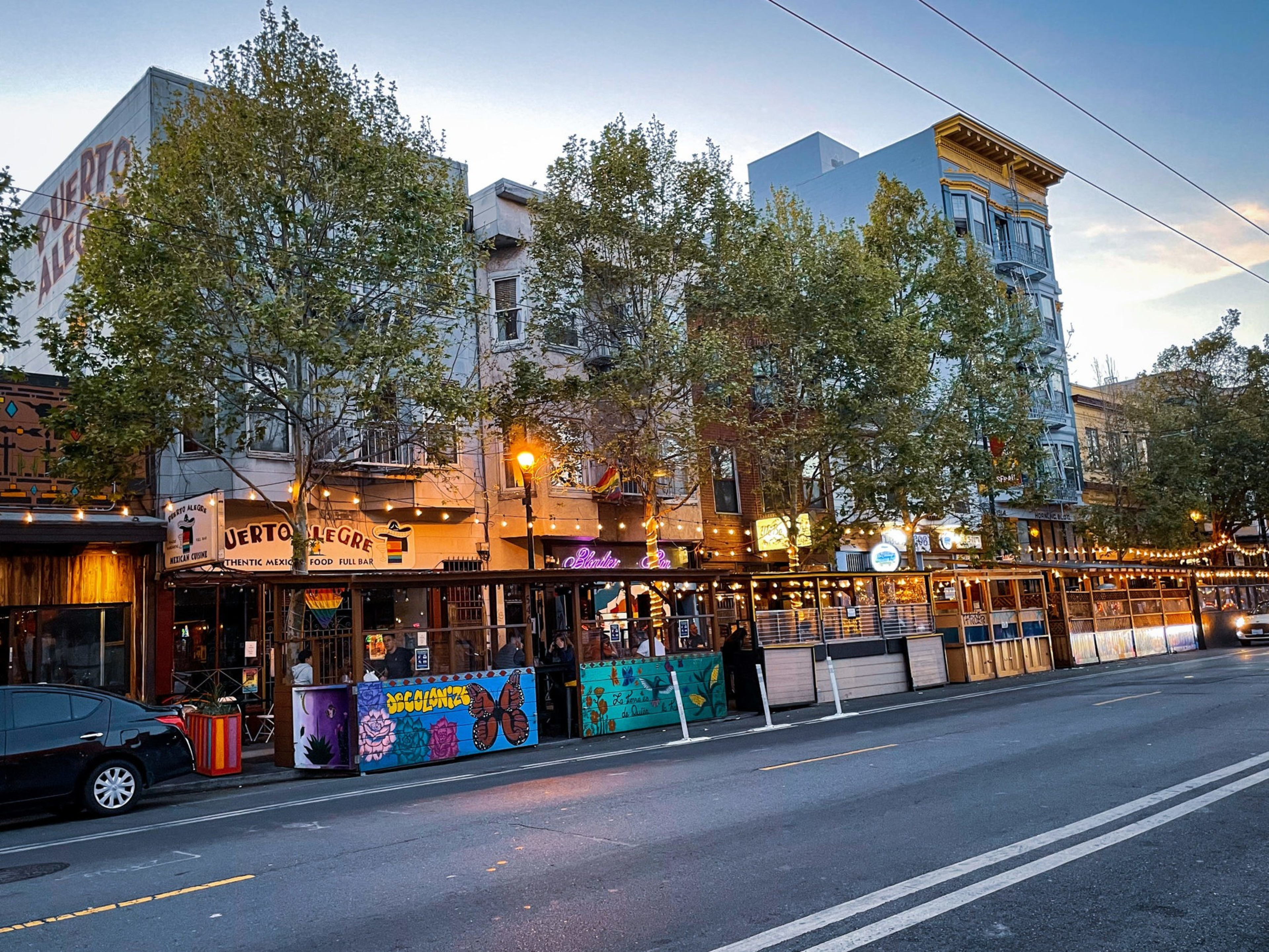By many accounts, Downtown San Francisco is in a so-called “doom loop (opens in new tab),” with dying shopping centers and empty storefronts serving as harbingers of the apocalypse. But where so many see doom and gloom, some with a creative mindset see sparkling opportunity.
While the City by the Bay’s high cost of living is notorious for pushing out artists (opens in new tab), it’s the very artists that have been driven out who could be the ones to help save it, with a crush of creative proposals—from pop-ups to Indian dancing nights—put forth to revitalize the city’s economic core.

Here are three not-so-modest artistic proposals for reviving Downtown—from turning the area into a stage to bringing a bit of Burning Man to its streets. Some are straightforward applications of art to sidewalks and the sides of buildings, while others are novel and a bit lofty—but hey, anything beats dreaming of doom loops, right?
Proposal 1: ‘Downtown as a Stage’
Transforming Downtown into a platform for art events and experiences is one strategy of the Public Realm Action Plan (opens in new tab), which calls for transforming particular areas of Downtown with the expansion of pedestrian-friendly zones, parklets, pop-ups, bike amenities, landscaping, murals and cultural events. One section of the plan is even dedicated to reimagining “Downtown as a Stage” or “canvas.”

The proposal, designed by Sitelab Urban Studio for the Downtown SF Partnership, identified art installations—like Let’s Glow SF, which brought 51,000 people and $3 million to Downtown San Francisco last holiday season, according to official estimates (opens in new tab)—as key to revitalizing the city’s core and changing the all-work-and-no-play narrative many associate with the Financial District.

To combat that perception, the Downtown SF Partnership will host an array of events this summer, from a Bastille Day celebration at Belden Place in July to a series of drag pop-up performances during Pride, cheekily called “Drag Me Downtown (opens in new tab).”
“Creating invitations to drive people back to downtown is essential not only for downtown recovery, but to avoid falling back into that [9-5 business] mono-economy, ” wrote Laura Crescimano, co-founder and principal of Sitelab, in an email. “Downtown has all the pieces to return to its vibrant self; it just needs reimagining,” Crescimano added.

The first pilot project that the organizations will deploy to test this theory is Landing at Leidesdorff, an initiative funded by the City of San Francisco expected to launch later this year. Located at the intersection of Leidesdorff and Commercial streets along the alleyways leading to Transamerica Park, the area will host happy hours and picnics and bring together local restaurants with live music, art and a rotating cast of SF makers and vendors.
While final plans for Landing at Leidesdorff are still in development, Robbie Silver, executive director of the Downtown SF Partnership, hopes that the space could offer everything from weekly yoga classes to book clubs. Landing at Leidesdorff will also pay homage to the bohemian history of Monkey Block (opens in new tab), a historic building that once sat in the footprint of the Transamerica Pyramid and saw the likes of Mark Twain, Jack London, Diego Rivera and Frida Kahlo (opens in new tab) pass through its halls.

“We believe that arts and culture—along with hospitality—is really going to help drive a new Downtown economy,” Silver said.
As for the pressing issue of the dollar amount for such endeavors, that’s still up in the air.
“That is a million-dollar question,” said Silver, noting that the Downtown SF Partnership is actively fundraising and seeking a mix of private and public funds.
Proposal 2: Bring Burning Man Downtown
Converting vacant office spaces into housing has been floated as one idea for giving a second life to desolate Downtown. But what about transforming those empty pillars of corporate America into artists’ co-ops, instead—and bringing the collaborative spirit of Burning Man Downtown?

That’s the proposal of P Segal—a writer, one of the instigators of Burning Man (opens in new tab) and a longtime fixture of San Francisco’s underground arts scene—who runs the nonprofit ArtHouse SF (opens in new tab). The nonprofit wants to purchase empty buildings from landlords through lease-to-own agreements to create co-ops where artists would work in creative commercial businesses on the ground floor of the buildings—think bookstores, galleries, coffee shops—and live in the spaces above while paying affordable rent. Burning Man’s “communal effort” principle (opens in new tab), which values creative cooperation and collaboration, underlies this model.
Landlords would have an incentive to either sell their properties to ArtHouse SF at a future date or partner with the nonprofit on a commercial venture to avoid the city’s vacancy tax, offset capital gains, receive a charitable tax deduction or show a loss on their taxes, Segal explained.

“It’s all about taxes,” she said.
Segal also believes the arrangement would appeal to landlords and investors who want to put a positive stamp on the city and wouldn’t mind some good PR. She acknowledges the model is unusual but believes it could be a solution to the city’s challenging rental market, especially for artists who might have difficulty showing a stream of steady pay stubs totaling three times the monthly rent as often required by a potential landlord.
“I like to think that we’re suggesting new molds for how to make things work,” she said.

Segal first came up with the concept a few years ago after learning that the city has a relatively high percentage of vacant residences (opens in new tab) and that 70% of artists had left the city (opens in new tab), according to one survey. Her own struggles securing housing in San Francisco as a working writer and her history with Burning Man as its first host (opens in new tab) have also shaped the proposal, which she believes could be the shot in the arm Downtown San Francisco needs.
“What Burning Man offers is actually art therapy on steroids,” Segal said. “People just feel better when they’re around art. […] When you put that kind of energy in a place intentionally, it’s like social engineering.”
While the group has identified some potential buildings (opens in new tab) and is seeking grants while accepting donations, (opens in new tab) Segal said the project’s implementation will depend on finding the right collaborators and properties.
Proposal 3: Play Up Pop-Ups and Cultural Districts
Over the last seven years, the art nonprofit Kultivate Labs has shown a track record of economic success tied to its long-running Undiscovered Creative Market. Once a night market highlighting Filipino food, artists and vendors, the event has transformed into a daytime block party doing the same.

Last year, the market brought in over 6,000 attendees, and the event series had its most successful year, generating more than $130,000 in economic activity—double its pre-pandemic average of $60,000, according to a press release (opens in new tab). Over the course of five years, the market’s vendors have generated over $930,000 in sales, and small businesses that have worked with the market since its inception, like Chase Center’s Filipino eatery The Sarap Shop (opens in new tab), have grown successful (opens in new tab) and gained a following.
Now Kultivate Labs is even more focused on translating such pop-up successes into an established commercial corridor on Mission Street between Fourth and Sixth streets in the SOMA Pilipinas Filipino Cultural Heritage District.

“Our whole model is really to uplift and incubate Filipino American small businesses and get them ready to potentially have a brick-and-mortar,” said Gina Rosales, Undiscovered’s co-founder and producer.
Undiscovered Creative Market is scheduled for three dates between August and October and will celebrate 50 years of hip-hop culture as part of its mission to nurture creative small businesses and bring empty streets alive with culture. Rosales points to the market’s ability to draw thousands of visitors to desolate streets as a successful data point.

“Look at what we can do with an empty parking lot—bring 6,000 people out to spend money and support small businesses and support artists,” Rosales said. “What if we had a giant space like that to activate and program on a daily basis?”
Kultivate Labs is also working with The Metreon to fill eight vacant spaces with Filipino pop-up vendors, Kultivate Labs’ executive director Desi Danganan told The Standard. Danganan also hopes that Kultivate Labs’ previous endeavors—from transforming a parking lot into Kapwa Gardens (opens in new tab) to turning an empty storefront into a thriving Filipino arts accelerator (opens in new tab)—can be cultural blueprints for Downtown (opens in new tab) moving forward.

“With the downturn and the shift in the economy, what’s going to be that spark that makes San Francisco roar back to life? It’s going to be arts and culture,” Danganan predicts. “Whenever there’s a forest fire, it gives an opportunity for new seedlings to come up.”
But Are These Proposals Viable?
Some have opined that throwing up light art installations or inviting musicians to play lunchtime concerts is not enough to save an urban swath as large and economically critical as Downtown San Francisco.
“If you also want a document that offers a realistic blueprint for bringing the city’s Financial District back to life, keep looking,” wrote The Chronicle’s John King (opens in new tab) of the Downtown SF Partnership’s Public Realm Action Plan.

But the current proposals involve more than splattering paint on sidewalks, and the use of art to revitalize urban areas is an effective and common strategy, noted Gordon Douglas, an urban planning associate professor at San Jose State and director of its Institute for Metropolitan Studies.
From the small steel town of Braddock, Pennsylvania (opens in new tab), to the megalopolis of Detroit (opens in new tab), municipalities across the nation have deployed such creative placemaking tactics to recharge blighted, post-industrial areas—and San Francisco itself offers many promising prototypes of tactical urban interventions, Douglas observed.

He points to the popularity of the city’s pandemic-born parklet program and the transformation of Hayes Valley (opens in new tab) and Valencia Street into vibrant commercial corridors as successful examples. However, he doesn’t think that artists moving into empty buildings is a panacea for all of Downtown’s economic woes.
“Like, how many Salesforce towers can we fill with artists?” Douglas challenged.
He thinks that the city’s core will need to undergo an urban revitalization as vast and ambitious as that of Lower Manhattan after 9/11 in order to survive (opens in new tab).

Board of Supervisors President Aaron Peskin, for his part, doesn’t seem daunted and thinks that having more creative and cultural programming Downtown is a no-brainer. The SF politician, whose district encompasses the Financial District and Union Square, said that the nexus of transit, open-air plazas and museums in the city’s urban core make it perfectly positioned for a cultural renaissance—and even tossed off the idea that Union Square or Embarcadero Plaza could host an inner-city spinoff of Golden Gate Park’s popular Outside Lands Festival.

“This place is off-the-hook well-situated for bringing concerts [in] like Outside Lands,” Peskin said. “Let’s not have them in the outerlands. Let’s have them in the interlands.”
The San Francisco Bay Area Planning and Urban Research Association, aka SPUR, is also bullish on the arts for Downtown San Francisco.
“Investing in long-term and sustainable artistic initiatives not only attracts visitors but also promotes innovation and creativity, making San Francisco a more competitive and dynamic city,” Sujata Srivastava, the SF director of SPUR, wrote in an email to The Standard. “Beyond economic benefits, the arts foster community engagement, social cohesion, and a sense of belonging in our city. By providing affordable spaces for artists in downtown areas, we tap into their creative energy and contribute to the vibrancy of our neighborhoods.”

But history, Douglas said, may be the ultimate proof of concept for whether the artists’ ways could work. He cited the transformation of SoMa into a hot live-work scene after artists moved into the neighborhood (opens in new tab) as a tried-and-true example of creatives making a part of the city attractive and cool.
“It’s not exactly a novel idea for how to revitalize an area,” Douglas said. “It’s been the story of urban areas becoming trendy again for a long time.”
